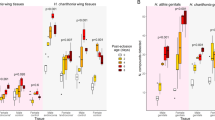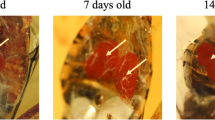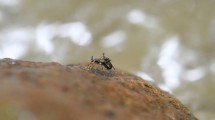Abstract
During the breeding season, female red-sided garter snakes (Thamnophis sirtalis parietalis) produce and express a sexual attractiveness pheromone that elicits male courtship behavior. Composed of a homologous series of saturated and monounsaturated methyl ketones, this pheromone is expressed in female skin lipids. Recent studies have shown that the sexual attractivity of unmated female garter snakes declines as the breeding season progresses. Here, we investigated whether temporal changes in the quantity and/or quality of the female sexual attractiveness pheromone are responsible for the observed loss of attractivity. Female red-sided garter snakes were collected immediately following spring emergence and held under natural conditions for the duration of the breeding season. Behavioral experiments confirmed that unmated females become significantly less attractive to males within two weeks of emergence from hibernation. Additionally, these females had lower estradiol concentrations at two weeks post-emergence. Subsequent chemical analyses revealed qualitative variation between the pheromone profiles of newly emerged females and those of females at two weeks post-emergence. Together, these results support the hypothesis that changes in the female sexual attractiveness pheromone are responsible for declining post-emergence female attractivity in garter snakes.




Similar content being viewed by others
References
Almli, L. M. and Wilczynski, W. 2009. Sex-specific modulation of cell proliferation by socially relevant stimuli in the adult green treefrog brain (Hyla cinerea). Brain Behav. Evol. 74:143−154.
Burken, R. R., Wertz, P. W., and Downing, D. T. 1985. The effects of lipids on transepidermal water permeation in snakes. Comp. Biochem, Physiol. 81:213−216.
Crews, D. 1976. Hormonal control of male courtship behavior and female attractivity in the garter snake (Thamnophis sirtalis parietalis). Horm. Behav. 7:451−460.
Crews, D. 1985. Effects of early sex steroid hormone treatments on courtship behavior and sexual attractivity in the red-sided garter snake, Thamnophis sirtalis parietalis. Physiol. Behav. 35:569−575.
Crews, D., Camazine, B., Diamond, M., Mason, R., Tokarz, R. R., and Garstka, W. R. 1984. Hormonal independence of courtship behavior in the male garter snake. Horm. Behav. 18:29−41.
Day, L. B., Fusani, L., Hernandez, E., Billo, T. J., Sheldon, K. S., Wise, P. M., and Schlinger, B. A. 2007. Testosterone and its effects on courtship in golden-collared manakins (Manacus vitellinus): seasonal, sex, and age differences. Horm. Behav. 51:69−76.
Garstka, W. R. and Crews, D. 1985. Mate preferences in garter snakes. Herpetologica. 41:9−19.
Gregory, P. T. 1977. Life-history parameters of the red-sided garter snake (Thamnophis sirtalis parietalis) in an extreme environment, the Interlake region of Manitoba. Nat. Mus. Can. Publ. Zool. 13:1−44.
Kubie, J. L., Cohen, J., and Halpern, M. 1978. Shedding enhances the attractiveness of oestradiol treated garter snakes and their untreated penmates. Anim. Behav. 26:562−570.
Lemaster, M. P. and Mason, R. T. 2001a. Annual and seasonal variation in the female sexual attractiveness pheromone of the red-sided garter snake, Thamnophis sirtalis parietalis, pp 369−376, in A. Marchlewska-Koj, J. Lepri, and D. Müller-Schwarze (eds.), Chemical signals in vertebrates 9. Kluwer Academic/Plenum Press.
Lemaster, M. P. and Mason, R. T. 2001b. Evidence for a female sex pheromone mediating male trailing behavior in the red-sided garter snake, Thamnophis sirtalis parietalis. Chemoecology. 11:149−152.
Lemaster, M. P. and Mason, R. T. 2002. Variation in a sexual attractiveness pheromone controls male mate choice garter snakes. J. Chem. Ecol. 28:1269−1285.
Lemaster, M. P. and Mason, R. T. 2003. Pheromonally mediated sexual isolation among denning populations of red-sided garter snakes, Thamnophis sirtalis parietalis. J. Chem. Ecol. 29:1027−1043.
Lemaster, M. P., Moore, I. T., and Mason, R. T. 2001. Conspecific trailing behavior of red-sided garter snakes (Thamnophis sirtalis parietalis) in the natural environment. Anim. Behav. 61:827−833.
Lillywhite, H. B. and Maderson, P. F. A. 1982. Skin structure and permeability, pp 397−442, in C. Gans and F. H. Pough (eds.), Biology of the reptilia: physiological ecology. Academic Press, New York.
Lutterschmidt, D. I. and Mason, R. T. 2005. A serotonin receptor antagonist, but not melatonin, modulates hormonal responses to capture stress in two populations of garter snakes (Thamnophis sirtalis parietalis and Thamnophis sirtalis concinnus). Gen. Comp. Endocrinol. 141:259−270.
Lutterschmidt, D. I. and Mason, R. T. 2009. Endocrine mechanisms mediating temperature-induced reproductive behavior in red-sided garter snakes (Thamnophis sirtalis parietalis). J. Exp. Biol. 212:3108−3118.
Lutterschmidt, D. I., Lemaster, M. P., and Mason, R. T. 2004. Effects of melatonin on the behavioral and hormonal responses of red-sided garter snakes (Thamnophis sirtalis parietalis) to exogenous corticosterone. Horm. Behav. 46:692−702.
Lutterschmidt, W. I., Lutterschmidt, D. I., Mason, R. T., and Reinart, H. K. 2009. Seasonal variation in hormonal responses of timber rattlesnakes (Crotalus horridus) to reproductive and environmental stressors. J. Comp. Phys. B. 179:747−757.
Lynch, K. S., Crews, D., Ryan, M. J., and Wilczynski, W. 2006. Hormonal state influences aspects of female mate choice in the Túngara frog (Physalaemus pustulosus). Horm. Behav. 49:450−457.
Mason, R. T. 1992. Reptilian pheromones, pp 114–228, in C. Gans and D. Crews (eds.), Biology of the reptilia: behavioral physiology. University of Chicago Press, Chicago.
Mason, R. T. 1993. Chemical ecology of the red-sided garter snake, Thamnophis sirtalis parietalis. Brain Behav. Evolut. 41:261–268.
Mason, R. T. and Crews, D. 1985. Female mimicry in garter snakes. Nature. 316:59−60.
Mason, R. T. and Parker, M. R. 2010. Social behavior and pheromonal communication in reptiles. J. Comp. Physiol. A. 196:729–749
Mason, R. T., Chinn, J. W., and Crews, D. 1987. Sex and seasonal differences in the skin lipids of garter snakes. Comp. Biochem. Physiol. B. 87:999−1003.
Mason, R. T., Fales, H. M., Jones, T. H., Pannell, L. K., Chinn, J. W., and Crews, D. 1989. Sex pheromones in snakes. Science. 245:290−293.
Mason, R. T., Jones, T. H., Fales, H. M., Pannell, L. K., and Crews, D. 1990. Characterization, synthesis, and behavioral responses to the sex attractiveness pheromones of red–sided garter snakes (Thamnophis sirtalis parietalis). J. Chem. Ecol. 16:2353−2369.
Mccune, B., Grace, J. B., and Urban, D. L. 2002. Analysis of ecological communities. MjM Software Design, Gleneden Beach, OR
Mcgraw, K. J. 2004. Winter plumage coloration in male American goldfinches: do reduced ornaments serve signaling functions in the non-breeding season? Ethology. 110:707–715.
Mendonça, M. T. and Crews, D. 1996. Effects of ovariectomy and estrogen replacement on attractivity and receptivity in the red-sided garter snake. J. Comp. Phys. A. 178:373–381.
Mendonça, M. T. and Crews, D. 2001. Control of attractivity and receptivity in female red-sided garter snakes. Horm. Behav. 40:43–50.
Mielke, P. W. and Berry, K. J. 2007. Permutation methods: a distance function approach. 2nd ed. Springer, New York.
Moore, I. T., Lemaster, M. P., and Mason, R. T. 2000. Behavioural and hormonal responses to capture stress in the male red-sided garter snake, Thamnophis sirtalis parietalis. Anim. Behav. 59:529–534.
Mougeot, F. and Bretagnolle, V. 2000. Predation as a cost of sexual communication in nocturnal seabirds: an experimental approach using acoustic signals. Anim. Behav. 60:647–656.
Neal, J. K. and Wade, J. 2007. Courtship and copulation in the adult male green anole: Effects of season, hormone and female contact on reproductive behavior and morphology. Behav. Brain Res. 177:177–185.
O’donnell, R. P., Shine, R., and Mason, R. T. 2004. Seasonal anorexia in the male red-sided garter snake, Thamnophis sirtalis parietalis. Behav. Ecol. Sociobiol. 56:413–419.
Parker, M. R. 2010. Activation, modification and suppression of sex pheromone production in garter snakes. PhD dissertation. Oregon State University, Corvallis.
Parker, M. R. and Mason, R. T. 2009. Low temperature dormancy affects the quantity and quality of the female sexual attractiveness pheromone in red-sided garter snakes. J. Chem. Ecol. 35:1234–1241.
Scordato, E. S., Dubay, G., and Drea, C. M. 2007. Chemical composition of scent marks in the ringtailed lemur (Lemur catta): glandular differences, seasonal variation, and individual signatures. Chem Senses. 32:493–504.
Shine, R., Olsson, M. M., Moore, I. T., Lemaster, M. P., Greene, M., and Mason, R. T. 2000a. Body size enhances mating success in male garter snakes. Anim. Behav. 59:F4–F11.
Shine, R., Olsson, M. M., and Mason, R. T. 2000b. Chastity belts in gartersnakes: the functional significance of mating plugs. Biol. J. Linn. Soc. 70:377–382.
Shine, R., Lemaster, M. P., Moore, I. T., Olsson, M. M., and Mason, R. T. 2001. Bumpus in the snake den: effects of sex, size and body condition on mortality of red-sided gartersnakes. Evolution. 55:598–604.
Shine, R., Phillips, B., Waye, H., and Mason, R. T. 2003a. Behavioral shifts associated with reproduction in garter snakes. Behav. Ecol. 14:251–256.
Shine, R., Langkilde, T., and Mason, R. T. 2003b. Cryptic forcible insemination: male snakes exploit female physiology, anatomy, and behavior to obtain coercive matings. Am. Nat. 162:653–667.
Shine, R., Phillips, B., Langkilde, T., Lutterschmidt, D. I., Waye, H., and Mason, R. T. 2004. Mechanisms and consequences of sexual conflict in garter snakes (Thamnophis sirtalis parietalis, Colubridae). Behav. Ecol. 15:654–660.
Shine, R., Wall, M., Langkilde, T., and Mason, R. T. 2005a. Battle of the sexes: forcibly inseminating male garter snakes target courtship to more vulnerable females. Anim. Behav. 5:1133–1140.
Shine, R., Wall, M., Langkilde, T., and Mason, R. T. 2005b. Do female garter snakes evade males to avoid harassment or to enhance mate quality? Am. Nat. 6:660–668.
Shine, R., Langkilde, T., Wall, M., and Mason, R. T. 2006. Temporal dynamics of emergence and dispersal of garter snakes from a communal den in Manitoba. Wildlife Res. 33:103–111.
Taylor, E. N., Denardo, D. F., and Jennings, D. H. 2004. Seasonal steroid hormone levels and their relation to reproduction in the Western Diamond-backed Rattlesnake, Crotalus atrox (Serpentes: Viperidae). Gen. Comp. Endocrinol. 136:328–337.
Vehrencamp, S. L., Bradbury, J. W., and Gibson, R. M. 1989. The energetic cost of display in male sage grouse. Anim. Behav. 38:885–896
Wabnitz, P. A., Bowie, J. H., Tyler, M. J., Wallace, J. C., and Smith, B. P. 2000. Differences in the skin peptides of the male and female Australian tree frog Litoria splendida. Eur. J. Biochem. 267:269–275.
Wagner, D., Tissot, M., and Gordon, D. 2001. Task-related environment alters the cuticular hydrocarbon composition of harvester ants. J. Chem. Ecol. 26:1245–1263.
Weiss, S. L. 2006. Female-specific color is a signal of quality in the striped plateau lizard (Sceloporus virgatus). Behav. Ecol. 17:726–732.
Whittier, J. M., Mason, R. T., and Crews, D. 1985. Mating in the red-sided garter snake, Thamnophis sirtalis parietalis: differential effects on male and female sexual behavior. Behav. Ecol. Sociobiol. 16:257–261.
Zar, J. H. 1999. Biostatistical analysis. 4th edn. Prentice Hall, New Jersey.
Acknowledgements
We thank the Manitoba Department of Conservation, Dave Roberts, and Suzanne Estes for assistance in the field and Al and Gerry Johnson for their support. We also thank Vanessa Uhrig and Chris Friesen for encouragement and help in reviewing this manuscript, Pat Aldrich for assistance with statistical methods, and two anonymous reviewers for constructive comments that helped improve this manuscript. This work was supported by a Western Oregon University Cummins Natural Sciences and Math Award to E.J.U., an NSF grant (0620125) to R.T.M., and a Western Oregon University Faculty Development Award to M.P.L.
Author information
Authors and Affiliations
Corresponding author
Rights and permissions
About this article
Cite this article
Uhrig, E.J., Lutterschmidt, D.I., Mason, R.T. et al. Pheromonal Mediation of Intraseasonal Declines in the Attractivity of Female Red-Sided Garter Snakes, Thamnophis sirtalis parietalis . J Chem Ecol 38, 71–80 (2012). https://doi.org/10.1007/s10886-011-0054-x
Received:
Revised:
Accepted:
Published:
Issue Date:
DOI: https://doi.org/10.1007/s10886-011-0054-x




